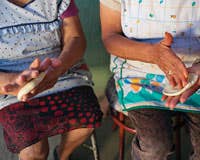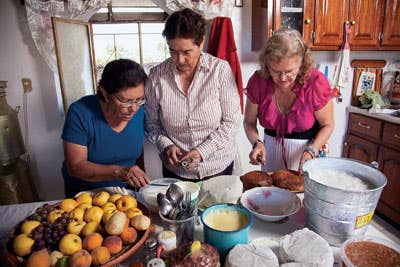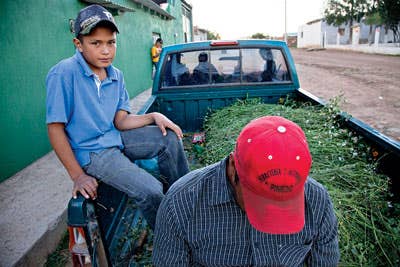
Mexico Feeds Me: Exploring Mexico’s Culinary Heritage
In rural Zacatecas, Mexico, a young writer explores his heritage by cooking the rustic, boldly flavored dishes of the region.
As our airplane made its bumpy descent for landing, out the window were scrubby green fields and brown dirt roads as far as I could see. My mother and I were on an Aeromexico connecting flight, one of those tiny planes that travel to Mexico's less glamorous regions—in this case, the rural desert state of Zacatecas, which lies just north of the center of the country. Its capital is the colonial city of Zacatecas, just 15 minutes south of the airport, a place built on the wealth of the silver mines that lie beneath it. But we were headed in the opposite direction. At the age of 21, I was finally going to visit my parents' birthplace, a stretch of parched ranch land between the towns of Fresnillo and Valparaíso. I had always heard tales of the place; now, all I could think about was the food.
I couldn't wait to eat an authentic gordita Zacatecana: a fluffy, griddled corn cake that puffs up and lets out a hiss of steam when it's ready to stuff with cheese, meat, or whatever vegetables are in season or on hand. If what I had heard from my family all my life was true, the real thing would be infinitely more delicious than the meat and bean gorditas I'd grown up eating in East LA. Finally, I would taste my Aunt Marta's famously pungent raw-milk cheeses at the source—fresh, not smuggled in and frozen. Since I was a little kid, my parents had tempted me with descriptions of the sweet queso de tuna—a kind of cactus fruit taffy—sold in the local street markets, and the bright orange and pink, vanilla-flavored fresh cactus fruits that grew wild around their childhood homes. Up until now, these foods had been folklore to me.
My mother immigrated to the U.S. in her cousin Ruben's red Buick back in 1961, but she's never stopped missing the ranchito (ranch village) of her childhood. For a long time, she went back at least once a year to visit her family and stock up on Marta's beautiful cheeses. (Our freezer at home always looked as if it were ready for World War III.) But she'd made the trip less frequently in the last decade or so. "Ya no era lo mismo," she said: It wasn't the same. Her beloved Aunt Nachita, who'd helped to raise her, had died, and in recent years, the oppressive narco-violence that's troubling other parts of Mexico had made its way down to even the smallest Zacatecan ranchitos.
This time around, I insisted on going with her; she insisted on going in August, just after the peak of summer, the "season of the waters," as it's known in Zacatecas. "When everything is green and abundant!" she told me in excited Spanish. As our rental car hurtled deeper into the countryside, I understood. As if by magic, the desert had erupted with life. The foothills in the distance were blanketed in grass and dotted with grazing cows. Tree-size nopales (prickly pear cactus) had reached Jack and the Beanstalk proportions. Some were the height of two-story houses, with thick paddles that bore at least eight fat, multicolored fruits each, vivid against the clear blue sky. In the cornfields, burly ears hung from thick stalks taller than me.
We bypassed my mom's village, La Yerbabuena, which lies about a mile off the curvy, two-lane highway, and headed for the nearby town of Fresnillo to stay with my aunt Margarita Morales. She moved out of La Yerbabuena in 2000, tired of having no running water and inconsistent electricity (though she still uses a wood fire to heat the water for her shower). It was just after noon when we arrived at her home, which was built by her husband, my Uncle Albino. Like the other houses on the rocky, unpaved street, it was simple and sturdy, fortified with metal bars and concrete posts.
I'd expected an emotional welcome, complete with awkward cheek-kisses, but nobody was home when we got there: Their pickup truck had broken down on the way back from the neighboring state of Aguascalientes, where they'd gone to visit my uncle's sisters. Fortunately, my aunt had left the keys with my cousin Sandra, who lives up the road. Once she let us in, we found a big pot of spicy menudo (tripe stew) waiting for us and some leftover sautéed cactus in the refrigerator. These were wild nopales, extra sour and more tender than the cultivated ones we're able to get back in LA. Around midnight, the rest of our family finally returned. "Ya llegó?por quien lloraban [(The one) you've been crying for?has arrived]!" my aunt joked as she opened the door slowly. (Her wry sense of humor is legendary in my mom's side of the family.) Aunt Margarita decided it wasn't too late to put out a proper welcome feast for us; the centerpiece was rebocado, a fragrant stew of pork spine and purslane. After the rest of us had gone to bed, my mother and aunt stayed up until 4 a.m. drinking instant Nescafé, catching up, and laughing loudly.
I had deliberately arranged for us to arrive just in time for Fresnillo's Sunday tianguis, the big, weekly street bazaar—part farmers' market, part swap meet. Bargaining skills were as good as pesos here, my aunt told me, and you could get anything from laundry soap to cilantro grown in the vendor's backyard to the peyote-based arthritis balm brought down from the mountains by Huichol Indians. My mother and aunt insisted on arriving no later than 9 a.m. because they didn't want their produce to be all "revoltada y manoseada [touched up and bruised]."

There were towering piles of beans for sale everywhere; I never knew there were so many varieties. There was a bean for each month, named for when the vine blossomed: rosy pink flor de mayos, cream-colored flor de junios. There were also big, buttery patoles, known as scarlet runner beans in the U.S.—like lima beans, but even starchier and brawnier. I weaved up and down the rows entranced by the cadence of the vendors' repetitive chants: "Andale! Gorditas, quesadillitas, taquitos, atolitos!" My favorite find was an agua fresca de pulpa de coco, the coconut drink of my dreams. A blend of coconut meat and coconut water cooled with rough shards of ice, it was lightly sweet and creamy, full of satisfying morsels of tender coconut. I bought it from a vendor who came all the way from Guadalajara, in the neighboring state of Jalisco. "Es de puro coco natural, nada de azúcar [It's pure, natural coconut, no sugar]!" he said proudly.
We bought some gorditas de maíz crudo—crumbly cookies made of toasted purple corn, sugar, and lard—from an old man and his son. They had a couple of wicker baskets piled high with the lavender-colored treats, which tasted like the browned edges of corn bread. A little boy walked by selling slices of tres leches (three milks) cake drenched in coconut milk and topped with sliced peaches. One row over, we found camotes (sweet potatoes) braised in huge brass pots bubbling away with molten piloncillo (brown sugar) syrup. In another booth, there were elotes tatemados, corn on the cob roasted for hours in a wood-burning clay oven. They're bought and chomped on as is, without condiments or seasonings—just the mother grain, pure and simple.
Even after all that snacking at the market, Aunt Margarita served us fava bean soup and asado de bodas, a rich pork and red chile stew, when we got back to her house. We quickly felt at home there, and we fell into a rhythm of setting out to visit a different family member every morning. Each day would bring a new—yet familiar—dish. At the small adobe home of my cousin Chuyita Sanchez, in the ranch town of San Pablo, I had a tart and spicy green mole made with boiled tomatillos, jalapeños, and cilantro, along with a stewed young chicken that Chuyita had killed that morning. Unlike the better-known moles of Puebla and Oaxaca, the moles of Zacatecas are lighter and simpler. This one was based entirely on fresh ingredients abundant during this season, rather than the dried chiles and nuts typical of those southern Mexican moles.
In San José de Llanetes, a tiny ranch village surrounded by abandoned haciendas, we visited my 86-year-old great-uncle, Guadalupe Rojas, who had helped raise my mother after her own mother died. We dropped in and caught him by surprise. The produce truck had not yet rolled into the village, so his refrigerator was empty. He was embarrassed and offered to go to the market to buy some cheese to make quesadillas, but I suggested we make a guiso (sauté) with whatever he had growing in his garden. Uncle Lupe agreed, but very reluctantly: In Zacatecas, to serve your guests a meal without meat or cheese is frowned upon. Luckily, it was the peak of the squash blossom season. His garden was overflowing with the flowers, hundreds of little yellow prom dresses drooping down over broad, green leaves. We threw together a guiso using both the tender, fat squash cut into cubes and the delicate blossoms, along with half an onion, a shriveled jalapeño, and a few overripe tomatoes he happened to have on hand. "Oye?son buenos!" my uncle admitted. He ate at least nine tacos stuffed with the spicy vegetable sauté. Aha, I thought, this must be the side of my family where I got my fast metabolism.

Zacatecano ranch life, as my mother knew it growing up, was often vegetarian by default. She's always reminded me how lucky they were if they even had beans to eat, let alone fresh meat or dairy products. To this day, my mother eats a couple of corn tortillas smeared with a tablespoon or two of spicy salsa and calls it a meal. Cooking with a recado—a sofrito-like flavor base made by pureeing tomatoes, onions, garlic, and salt—was the best way of maximizing flavor and stretching the available vegetables, which might be as sparse as a few ears of corn or as generous as a larder full of chayotes, green beans, potatoes, and peas. On this trip, I finally stopped taking for granted that mindful, resourceful way of cooking, eating, and living. The day I considered myself an adult was the day my Aunt Margarita taught me to shape a real gordita from fresh masa. It was my ancestral food, and it had finally become my own.
The family member who probably demonstrates that spirit of self-sufficiency best of all is my Aunt Marta. Though not my aunt by blood, Marta was raised along with my mom by my great-uncle for a time and is definitely family. At seven years old, her aunt Carlota Cabral, a fourth-generation cheese maker, took Marta in as her own and instructed her in her craft.
We spent a couple of days with Aunt Marta and her sons Octavio and Juan Carlos at their beautiful home in my mom's home village, La Yerbabuena. Their house lies at the top of a rocky road, perched at the village's highest point; the courtyard, with its fig and pomegranate trees, overlooks the entire village, as well as the green foothills in the distance. They keep the cows in their potrero, an open range about a mile away. A decade ago, Marta's husband moved to the U.S. for diabetes treatment; now it's just Marta and the boys tending to their 30 dairy cows, four enormous pigs, and dozen or so chickens.
Aunt Marta's rich, raw asadero cheese is like fresh mozzarella in texture. It is made with the leche de apoyo, an extra-fatty reserve of milk produced by the cow to nourish her calves. We watched my cousins coax the heifer into releasing the good stuff by bringing a calf and letting it feed for a few seconds to get the leche de apoyo flowing. My mom eagerly accepted a shot of it still warm from the cow.
Back in the kitchen, Aunt Marta cheerfully proclaimed, "No más para ustedes [Just for you]!" as she presented us with a block of fresh cheese made earlier that morning. It sat in a pool of whey and was just firm enough to slice with a dull knife. We scooped pieces of it with toasted tortillas and ate it along with my aunt's fried potatoes in chile rojo. Intense and briny, it was a knockout, unlike any I'd tasted before.
Later, my aunt showed me how it's made. As soon as the boys bring in the tin buckets overflowing with warm milk, she gets to work. Typically, she adds rennet to the buckets, then cooks breakfast while the curds and whey separate; by the time she's washed the dishes, the curds are ready to be pressed. She wraps them in cloth, places them in a hollowed-out log with a drainage hole drilled in it, then sets heavy stones on top to press out some of the whey. Once the cheese is pressed, she simply salts it, if it's to be a block of fresh asadero; if she's making the firmer rounds, called panelas, she takes the pressed cheese and grinds it, salts it, and forms it into variously sized disks. The panelas are then coated in a red chile paste, pressed under more heavy stones, and left to age for three days at room temperature in her cheese cave, then for one day in the open air to cure and form a rind.
My aunt and cousins produce 25 cheeses daily and sell them right there at the farm to the same customers they've had for years. The day I was there, a man came over from a neighboring village and loaded 12 cheeses into the back of his truck to share with his daughters, who were visiting from the U.S. When I asked why he went out of his way to get my aunt's cheese, he said, "Pues?el sabor no hecha mentiras [Well?taste doesn't lie]."
When it came time for my mother and me to head back to the airport, instead of complaining about the heat, as I had upon arrival, I stopped to savor it and take one last breath of desert air. I hugged my relatives goodbye and kissed their cheeks, no longer with awkwardness, but with with a warm familiar feeling.
Photographs by Todd Coleman
Keep Reading
Continue to Next Story










